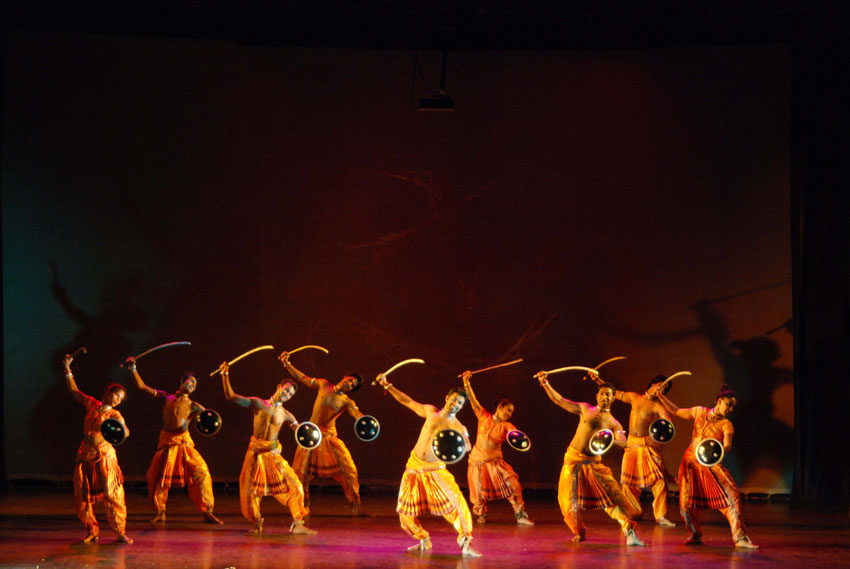
Chhau Dance
Chhau is an ancient dance form. It originated in the mock fights of the Oriya Paikas (warriors) who fought rhythmically to the accompaniment of indigenous musical instruments. It is prevalent in Mayurbhanj district in Orissa, Sareikela in Bihar and Purulia district in West Bengal. The dance form was nurtured and developed under different royal patronage. Maharaja Krishana Chandra Bhanj Deo of Mayurbhanj was its greatest patron. Basically, Chhau is a festival dance, performed on the occasion of the sun festival observed according to the Bengali calendar towards the end of the month of Chaitra. Nowadays, Chhau is not only performed on this sun festival but also during many other festivals at other times of the year.
Origin of Chhau Dance
It is said that the word 'Chhau' is derived from the Sanskrit word 'Chhaya', which means shadow or image. In Oriya 'Chhauka' means ability to make a sudden unexpected attack. Chhau dance perhaps originated from the martial dance Phari Khanda Khela (playing with the sword and the shield). Some say the word 'Chhau' has been derived from 'Chhauni', which means military barracks. Most of the tribal people performed it in an effort to appease and influence the Sun God. Whatever may be the origin of this folk drama in course of time it has developed its own rules and grammar. Nowadays, Chhau dance is generally performed during the Chaitra Parva. Gradually this dance has shifted from the barracks and has taken a ritualistic turn.
Theme of Chhau Dance
The Chhau dance is mythological, as it is mainly based on various episodes of the epics Ramayana and Mahabharata. Sometimes certain episodes of the Indian Puranas are also used. The individual dance items of Chhau dance of Mayurbhanj include solo, duet and group performances. Two Rasas are dominant in the performance- Vira and Rudra, and in the end, forces of evil are punished and the righteous triumphs.
Music in Chhau Dance
Most of the tunes for Chhau are traditional and folk which are played on Mahuri and various types of drums. The music appropriately reflects the moods which the dancers so impressively interpret. The use of the drum is an important part of Chhau performance. With the beating of drums an invocation to Lord Ganesha is given and the dance begins. As the singer completes the invocation song, a host of drummers and musicians start beating the Dhol and the Dhamsa. The musical part is an integral prelude to the actual dance performance. After this musical journey, the character of Lord Ganesha appears on the dancing ground followed in quick succession by other characters -gods, demons, animals and birds.
Costumes of Chhau Dance
The costumes of the Chhau performers are of various colours and designs. It mainly comprises of Pyjamas in deep green or yellow or red shade that is worn by the artistes playing the role of gods; whereas those playing the role of demons have on loose trousers of a deep black shade. Sometimes, stripes of contrasting colours are also used to make the costumes more attractive and different. The costumes for the upper part of the body are full of various designs. The costumes for the character of Goddess Kali are made up of cloth of unrelieved black, and to express the separate and distinct identity, the characters of animals and birds use suitable type of masks and costumes.
Performance of Chhau Dance
Chhau dance is mostly performed in the open space or ground field during the night.
The dancers take a bath and do Puja before performing this dance, in order to maintain
the sacredness of dance as the characters in the dance are of gods. Generally, fire
poles called Mashaal surround the dance arena, for the purpose of light. The masks
generally used for Chhau are made up from the clay and paper. In the performance
of the Chhau, some of the characteristics of primitive ritualistic dances are noted.
This is also seen through its vigour, style and musical accompaniment mainly with
the drum.
As it is compulsory for all the characters in the Chhau dance to wear masks, various
body movements, including movements of the peaks of the masks are used to illustrate
different moods. The mask movements show anger, while shoulder and chest movements
indicate joy, depression and courage etc. Jumping in the air is another movement,
which serves as a gesture of attack during the enactment of a war scene.
Thus, we find an interesting phenomenon in Chhau dance. A dance form, which originated
in military barracks, in course of time, developed religious and secular dimensions.
A folk form taking a more systematic rigid form by adopting some Sastrik canons.
It is said that, the best Chhau dancers are from Baghmundi.
Source : India Net Zone